I need help!
Hi we found this bike under a pile in the garage I'm clearing out for an estate. The man was a hoarder, his dad was too. I know nothing about bikes and parts. I found one number by the left wheel and that's all. Help is needed. Message me directly and any help is appreciated.
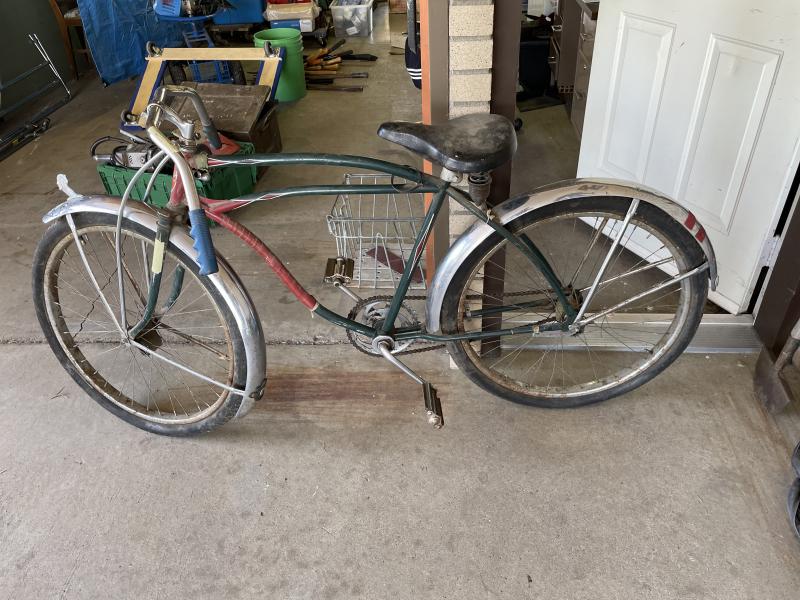
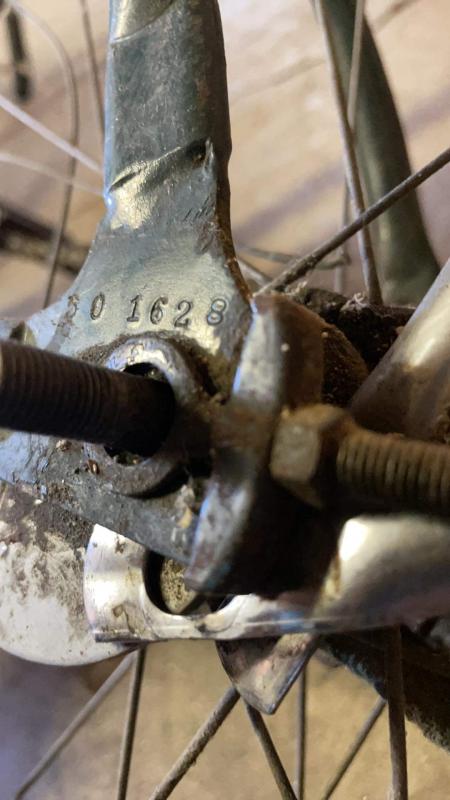
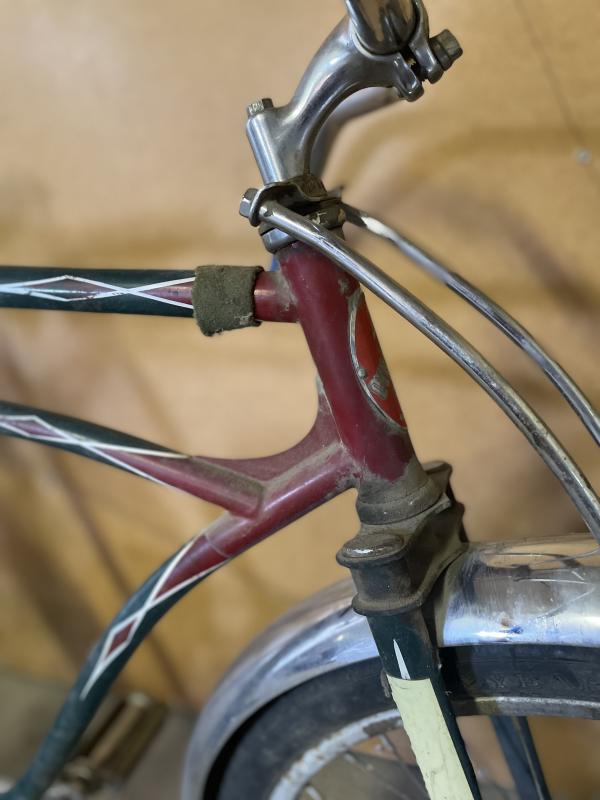
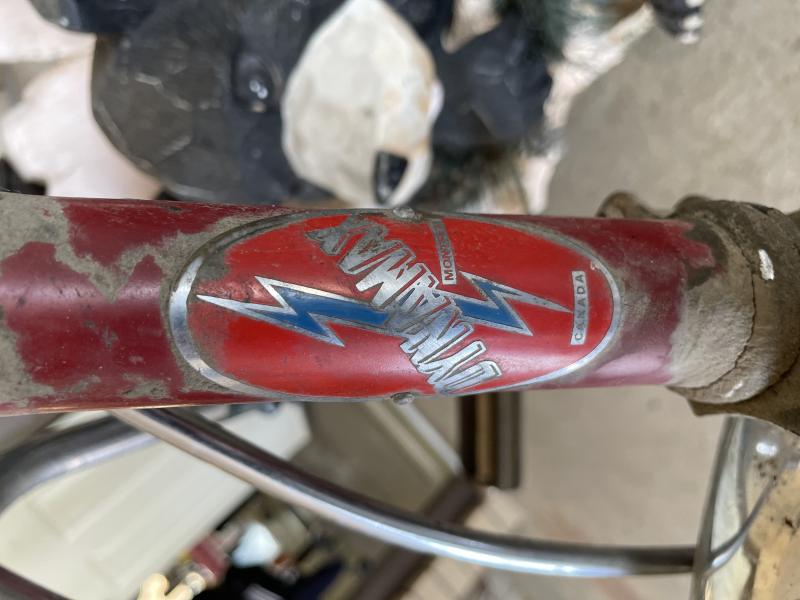
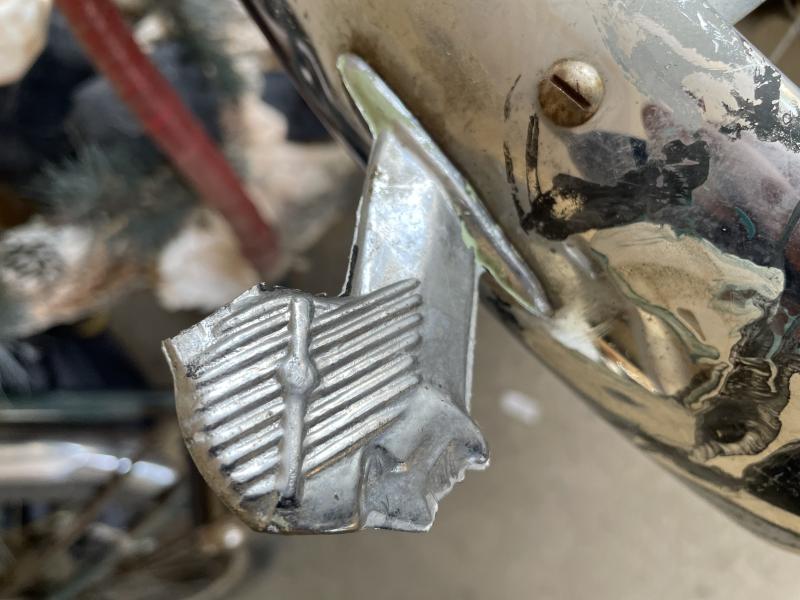





This bike was made by Mtobecane in Quebec using the name "Dynamax". It was probably made around 1953.
How do you know this, I cannot find any info or pictures
I own a Dynamax racing bike. I know that it was made by Motobecane in Quebec. Trade information for bicycle manufacturers in Canada only lists Dynamax as operating in 1953. I have had my Dynamax for many years. Information is very scarce, but in that time I have seen a few pictures of Dynamax bicycles.
So I have something pretty rare then. How would I price it? And where can I sell it. I'm selling for an estate
Where are you located?
Located in Medicine Hat, Alberta
In the four months since we started discussing some of the smaller Québecois manufacturers, I've managed to research some more information on Dynamax.
Dynamax Limitée was founded in August 1943 by Henri Gérin-Lajoie, Charles Joseph Gélinas and Cecil Herbert Macnaughten. The original mandate covered a wide scope to, "manufacture, construct, repair, buy, sell, let, hire, exchange, trade and deal in all kinds of tools, machines, machine tools, implements, hardware, locomotives, engines, railway cars and supplies, automobiles, motors, electrical apparatus, compressors, mining and pumping machinery and tools, cranes, shovels, tractors, dredges, boilers and generally every kind and description of tools, and every kind and description of machinery." While bicycles are not specifically included, they would be covered under the very broad scope.
The earliest mention of Dynamax bicycles that I've uncovered is the donation of a club racer style bicycle for a prize at a 1952 race. By 1953, the company was employing 50 people who were manufacturing 90 bicycles and 15-20 Mobylette mopeds per day, in the 10,000 sq. ft. workshop located in the Ville St. Michel district of Montreal, under Managing Director Jean Jacques Rakover. In addition to bicycles and mopeds, the company also offered Dynaflash light motorcycles, though it's unclear if they were manufactured at the factory or imported. Prior to manufacturing complete bicycles, the company was manufacturing bicycle frames and forks, so they appear to have been in the bicycle industry prior to 1952.
By at least 1953, Dynamax was a subsidiary of Motobecane of France. This may have occurred in 1952, when there was as additional stock offering of $200,000.00.
There were three different "series" of bicycles, in addition to a children's line. The three series were described as "sport, course and comfort", with the latter having the additional descriptor of "Canadian style". Consequently, I suspect this latter reference is to a roadster style bicycle with a single speed, coaster brake hub. Some period advertisements mention Dynascout bicycles and I've also seen reference to Dynaclub, so the three "series" may actually have been marketed as separate brands.
Dynamax was heavily involved in promotion during 1953-1954. They sponsored races and a cycling club/racing team during this era, as well as advertising in local newspapers. Based on period advertisements, there were at least four shops in the Montreal region that carried Dynamax brands.
The company officially dissolved in October 1959 though they may have been inactive for some time prior to that. I have yet to uncover any objective evidence of Dynamax bicycles for the 1955-1959 period. However, it is clear that they were in operation for more than the single year of their inclusion in the federal government reports on the bicycle industry.
Dynamax, as a brand, continued to survive, manufactured in France by Motobecane. They were marketed in Canada during the early 1970s bicycle boom. Though not as widely distributed as Motobecane in the USA, I recall them from this period and have seen a handful of survivors.
Attached is a Dynamax advertisement form 1954 and a couple of photos from the 1st (1954) edition of the Tour du St. Laurent, a stage race sponsored by Dynamax that covered a circuit from Quebec City to Montreal, via the Eastern Townships, then back to Quebc CIty along the north shore of the St, Lawrence River. Its four stages covered 340 miles over 2 days. In the start line photo, there are three Dynamax riders on the left side of the photo, in the 2nd and 3rd rows. The other photo shows Mademoiselle Dynamax congratulating a winning cyclist from the rival Gachon-Terrot team.
FYI, the broken, Indian head mascot on the front mudguard of the subject bicycle is not OEM. It's depicted as an accessory in one of the 1950s CCM catalogues.
John,
I notice that the OP's bicycle has serial numbler 50 1628, with a distinct space after the first two characters. Consequently, I'm wondering if the "50" might represent the model year? Could you please check your Dynmax serial number to see if it fits this format? TIA.
Yes it is 50 then a gap between the numbers 1628. According to a ccm chart I've seen, it lists they only made Dynamax in 1953
Yeti4 lyfe,
I suspect the chart you saw, was the one that I compiled based on annual bicycle industry reports issed by the Canadian government. CCM was not involved, other than making submissions regarding their own operations.
The content of the report was the matter of some discussion, particulalrly as to whether the submissions were voluntary or mandated and what was the government's definiton of a bicycle manufacturer for inclusion in the report. There was a discliamer in the 9th paragraph of the post stating that, " it may not be all inclusive for either dates or manufacturers". We now know that to be true and have evidence that Dynamx manufactured bicycles for than just 1953.
Ok so what do I have, is the 50, the year it was made then?
Maybe, it's a possibility. That's why I asked John for his serial number. Having two Dynanax serial numbers may give a better appreciation of whether or not the first two characters could be a year indicator.
https://www.kijiji.ca/v-art-collectibles/medicine-hat/vintage-1953-ccm-dynamax/1585239131
Hi Tmar,
I am sorry to take so long to respond to your question about the serial number on my Dynamax racing frame. The serial number is 5095P. It is a top quality racing frame and I am almost certain that it dates from 1953.
Thank-you for posting. Unfortunately your format is the same as the OP's. Consequently, I'm assuming your frame was manufactured in France by Motobecane. I'm assuming the BB shell uses the French threading standard?
It is possible, but the headbadge says "Dynamax Canada" on it. If I remember correctly, it is also set up for 27 X 1 1/4" wheels. I will pull it down again from my shelf in the garage and check the bottom bracket threading. I know that the components used on the bike were all French. The rear derailleur was a Huret "Louison Bobet" model, which also helps to date it. Unfortunately, I only purchased a frame many years ago on Ebay when it was up for auction. I know that the Canadian rider, Pat Murphy, rode a Dynamax before he started riding CCM Flyers around 1954. A few years back he was still akive and living in the Chicago area. After he left Canada he worked for Schwinn in Chicago. He had an extensive knowledge of CCM in the 1950's, and also Schwinn.
It does seem a little hard to believe that Motobecane would move enough resources to Montreal to manufacture a small number of specialized racing bikes. I have seen lots of Reynolds 531/Nerrvex-lugged racing frames over the years, and the workmanship on the Dynamax frame is top notch.
The Huret Special "Louison Bobet" rear derailleur dates from 1953. Also, could the P at the end of the serial number stand for Paris?
The "P" suffix in the serial number may refer to Pantin, the Paris suburb where the Motobecane factory was located. Pre-1975 Motobecane head badges bear the Pantin location.
As for the Huret Louison Bobet derailleur, while it was reportedly introduced in 1953, it was not a single year model. It was being catalogued as late as 1956 and there is some evidence to indicate it may stll have been in production as late as 1958.
One could even argue that Bobet's name did not have enough prestige to merit an eponymous derailleur until after he had won the 1953 Tour de France in late July. The negotiations to arrange a licensing deal and the subsequent time to change packaging and documentation could have delayed introduction far enough into late 1953 to make it a 1954 model year introduction.
Consequently, while your bicycle may be a 1953 model, it could also be later. Evidence indicates that neither Dynamx nor the Huret Louison Bobet derailleur were restricted to 1953 production.
Pat Murphy had a 1953 Dynamax just like mine and if Pat says he had it in 1953, I am sure that he did. CCM introduced their Prolite Flyer road bike in 1954 in time for the British Empire Games in Vancouver. Some Canadian riders who participated had the new Flyers. The Prolite Flyer frames were almost identical to the Dynamax racing frames. This may have affected Dynamax's decision to market their racing model in Canada.
The Louison Bobet Model Huret derailleur was almost obsolete in its first year of production because it was a twin cable plunger type derailleur. It did not have a spring to provide chain tension. Chain tension was adjusted using a second control lever and cable. The main control lever shifted the gears. A similar system was used by Campagnolo when they produced the first version of the Gran Sport paralellogram derailleur around 1950. This was short lived and almost all subsequent production versions had a spring to provide chain tension. The first version of the Campagnolo Gran Sport derailleur is now worth thousands to collectors. The Huret Louison Bobet derailleur is also fairly valuable as a collectors item.
CCM chose to use Cyclo Benelux derailleurs on its 1950's Fl;yers. These were nowhere near as good as the Campagnolo derailleurs. Around 1956, Campagnolo sent Pat Murphy one of their derailleurs to use on one of his CCM Prolite Flyer road bikes.
The Dynamax racing frames used the first series of Nervex Pro lugs that were replaced by 1955. CCM also used the first series on their Prolite Flyers, but they made so few of them that the remainder of their frame building supplies eventually fell into the hands of Mike Barry at Bicycle Specialties. They were used in the construction of Mariposa frames.
The old addage,"What wins on Sunday, sells well on Monday" has always been applicable to high end bicycle sales. Bobet won the 1954 Tour de France, the 1954 World Championship Road Race and the 1955 Tour de France using the subject derailleur. Consequently, there is no reason not to believe that sales of this derailleur would not have been healthy past 1953 and at least into 1956, particulalry in French language markets.
Campagnolo's 1950 parallelogram Gran Sport did not immdediately obsolete all other derailleurs. The two major French derailleur manufacturers, Huret and Simplex, did not introduce parallelogram derailleurs unti 1958 and 1961 respectively. The Tour de France was still being competed on a national team basis until 1962, when trade teams were re-introduced. Consequently, there was a lot of national pride at stake and French riders were put on French bicycles with French equipment. Campagnolo's Tour de France successes during this period were with Italian riders or those from other nations, such as Koblet (Switzerland), Bahamontes (Spain) and Gaul (luxembourg)..
While Mr. Murphy's bicycle may be a 1953 model, that does not necessarily mean that your is, despite it being indentical. Bicycles do not necessarily change with every model year and the Louson Bobet derailleur was winning high profile races to ensure it's popularity into the late 1950s. So, while your bicycle may be a 1953, I wouldn't rule out a slightly later model, given there is objective evidence of Dynamax production extending past 1953.
Most riders in the '50's would have preferred to use the Campagnolo Gran Sport derailleur. French made bikes were ,as a rule, fitted with French equipment, and Italian bikes had Italian equipment. I even remember seeing one British team that had all British equipment on their bikes. Simplex and Huret lasted through the '50's using the older piston style derailleurs, as did Cyclo. But eventually, heading into the '60's, they all brought out their own versions of a paralellogram derailleur similar to the Campagnolo Gran Sport (or Record, Nuovo Record, and Super Record). By the late '50's, Campagnolo had introduced masny other top-notch components, such as hubs, cranksets, seat posts, pedals, etc.). It was only a few years before almost all top notch riders were using Campagnolo equipment exclusively. Some French components were still the best, such as Mavic rims ( made under a licensing agreement with Fiamme ), and MAFAC brakes.
Professionals ride what they are given by the team. The bicycle frames, components and clothing are provided by sponsors as a result of business deals made with the team. These deals often have more to do with money than the products themselves. Campagnolo's dominance was the result his sponsorship of the top teams, not the merits of his equipment. This not to say that his equipment was bad, as it wasn't. However, with few exceptions, it also wasn't superior.
The derailleur systems are a case in point. After the Gran Sport, Campagnolo's derailleur performance actually lagged behind the flagship offerings of other top manufacturers. The subsequent Record, Nuovo Record, Super Record and C-Record were just updates to Gran Sport, with slightly revised geometry, new materials and revised styling. Campagnolo didn't introduce a truly new derailleur design until the very late 1980s and their shifting wasn't back on par with the competition until three decades later, in the very early 1990s.
O.K. Tmar, I surrender.